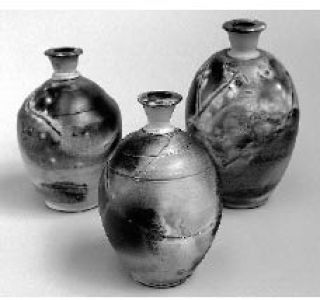Jeff Hanks’ expertly crafted pottery and my canvas “Live Sea Scrolls” would seem to have little in common. Yet we both found that we are working in very old mediums which overlap in man’s history.
Pottery was used in very ancient human settlements.Some of the settlements, with hot pits used as firing kilns, are now dated over 6,000 years old.
Hanks’ upcoming show features saggar-fired pieces, a more recent version of the firing pit, using a large ceramic container. Ancient pots took on additional artistic characteristics as the artisans scribed them with writing symbols denoting contents or giving them religious power. Some of the African writing on pots or slabs predates even Egyptian hieroglyphics.
I became interested in very old writing systems when I discovered that the common belief that Africans never developed written language was totally untrue. They had many written languages, anthropologists have discovered. Often they are artfully constructed, beautiful and mysterious. I started using them in my canvas scrolls in the last couple years. I had already been using Japanese Kanji writing in my paper media paintings for years.
The scrolls themselves are an ancient medium, although the creators of the pre-B.C. Dead Sea scrolls used animal parchment or papyrus for their writing. Canvas was not used commonly until the early 1400s. I use raw cotton canvas, liking the untreated canvas effect with lots of barely controlled bleeding and unpredictable affects. Staining with tea gives it this old, atmospheric look. I’m not yet ready to prepare animal skins for painting, although obviously, they would last!
Potter Hanks has some high-quality Lopez clay he acquired recently, and passed some on to me to experiment with. The Lopez clay is gorgeous stuff, but I’ve learned great respect for Jeff’s handling of it after my multiple awkward attempts and small-scale disasters. Nevertheless, I’ll use some in at least two art pieces. Hanks intends to fire some pieces made of the local clay, which is also an ancient way of working. Potters often dug up their own clay, and still do in some parts of the world.
“There are some little stones in some of the Lopez clay,” says Hanks, “which may explode the pot in the saggar, or may show up as a nice texture on the outside.”
Another similarity between Jeff and I is that we both like the unpredictability of our processes The paint may bleed this way or that in the raw canvas, or the glazes may bleed one way or another. The saggar firing, at 1600 degrees, where salt or kelp is sometimes added during firing to the big container, will inevitably make fascinating salt-effect colors or patterns in Jeff’s pottery and is by nature unpredictable.
I feel that if everything were predicable, we might as well do engineering drawings or production wine bottles. It’s more possible pain, but more fun in this slightly crazy way.
My Island Boxes are also a bit crazy, some would agree. There, the materials and contents and hidden stories are no-holds-barred. But they have to be small, to fit in these little capsulated worlds. Art history is served, too: there were boxes with mysterious contents in King Tut’s tomb.
Our show runs at Chimera Gallery until Nov. 13. hours are 10 a.m. to 5 p.m., Thursday through Sunday.



